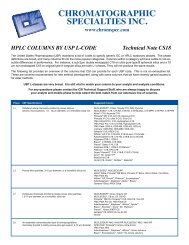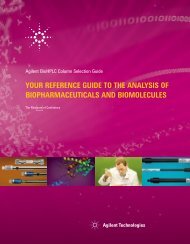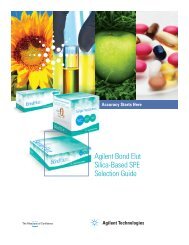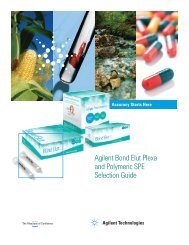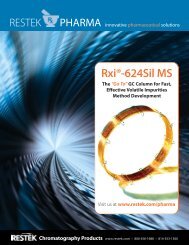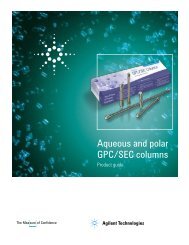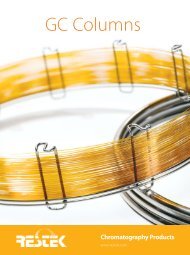Optimizing the Analysis of Volatile Organic Compounds
Optimizing the Analysis of Volatile Organic Compounds
Optimizing the Analysis of Volatile Organic Compounds
Create successful ePaper yourself
Turn your PDF publications into a flip-book with our unique Google optimized e-Paper software.
12<br />
Figure 8.<br />
Type “K” trap (Vocarb TM 3000 trap)<br />
showing <strong>the</strong> various layers.<br />
Vent<br />
Purge Flow<br />
10cm Carbopack B<br />
(for mid- and later-eluting volatiles)<br />
6cm Carboxen 1000<br />
(for gases)<br />
1cm Carboxen 1001<br />
(to prevent breakthrough)<br />
www.restekcorp.com<br />
Choosing <strong>the</strong> Right Trap for Your <strong>Analysis</strong><br />
Type “K” Trap (Vocarb 3000 Trap): The most effective trap on <strong>the</strong> market is <strong>the</strong><br />
Vocarb 3000 or type “K” trap (Figure 8). This trap has exceptional ability to retain highly<br />
volatile compounds like difluorodichloromethane with minimal bleed, activity, or breakdown,<br />
yet it works well for trapping higher boiling compounds like naphthalene and<br />
trichlorobenzene. The trap resists adsorption <strong>of</strong> water and methanol, and virtually eliminates<br />
<strong>the</strong> need for moisture control systems (MCS) and <strong>the</strong> dry purge step on <strong>the</strong> concentrator.<br />
Because this trap contains Carboxen 1000 adsorbent (described on page 11), which has a<br />
surface area <strong>of</strong> over 1200m 2 /g, a desorb temperature <strong>of</strong> 245°C is required when using<br />
Tekmar purge and trap instruments. For OI Analytical sample concentrators, such as <strong>the</strong><br />
Model 4560, <strong>the</strong> desorb temperature should be 220°C or lower. The lower temperature will<br />
prevent overshooting <strong>the</strong> maximum temperature <strong>of</strong> <strong>the</strong> trap, which would damage <strong>the</strong> packing<br />
materials (caused by <strong>the</strong> rapid trap heating rate, 800°C/min., <strong>of</strong> <strong>the</strong> OI system). 3 When<br />
using this trap be sure to verify performance. Non-linear response for chloromethane is a<br />
sign <strong>of</strong> breakthrough and an indication that <strong>the</strong> trap must be changed. Ano<strong>the</strong>r indication <strong>of</strong><br />
a defective “K” trap is loss in response for acrolein.<br />
Type “J” Trap (BTEXTRAP Trap): The “J” trap is excellent for concentrating gasoline<br />
range organics (GRO) because it retains less water and methanol compared to <strong>the</strong> “K” trap,<br />
and can withstand higher temperatures than <strong>the</strong> Tenax ® /silica gel trap. Because many GRO<br />
samples have high concentrations <strong>of</strong> gasoline components, it is necessary to dilute <strong>the</strong> sample<br />
in methanol, and this trap can accept a heavy sample load with percent levels <strong>of</strong><br />
methanol while still passing continuing calibration check criteria. The disadvantage <strong>of</strong> <strong>the</strong><br />
“J” trap is its limited ability to retain more polar analytes like <strong>the</strong> e<strong>the</strong>rs and alcohols.<br />
Laboratories analyzing for tert-butyl alcohol will attain lower detection limits by using <strong>the</strong><br />
“K” trap, compared to <strong>the</strong> “J” trap. For GRO samples containing methyl-tert-butyl e<strong>the</strong>r<br />
(MTBE), trap selection will depend on <strong>the</strong> sample matrix. When analyzing highly contaminated<br />
soils for MTBE, it is best to use <strong>the</strong> “J” trap. For cleaner samples, <strong>the</strong> “K” trap provides<br />
better sensitivity.<br />
Type “B” Trap (Tenax ® /Silica Gel Traps): Tenax ® /silica gel traps are used for a variety <strong>of</strong><br />
VOC methods. These traps exhibit better recoveries <strong>of</strong> polar analytes than <strong>the</strong> “K” trap, but<br />
<strong>the</strong> silica gel layer adsorbs water, methanol, and carbon dioxide. The Tenax ® /silica gel trap<br />
also has better lot-to-lot reproducibility compared to <strong>the</strong> “K” or “I” traps. For laboratories<br />
that are not trying to achieve MDLs for gaseous VOCs at concentrations above 10ppb, <strong>the</strong>se<br />
traps will work well. To achieve detection limits for gases at concentrations below 10ppb,<br />
<strong>the</strong> lower water and methanol retention <strong>of</strong> <strong>the</strong> “K” trap is recommended.<br />
Type “F” Trap (OV ® -1 /Tenax ® /Silica Gel Traps): Although <strong>the</strong>se traps are recommended in<br />
many EPA methods, <strong>the</strong>y exhibit more bleed and activity than <strong>the</strong> Tenax ® /silica gel trap,<br />
with no significant improvement in performance. This suggests <strong>the</strong> bleed originates from <strong>the</strong><br />
OV-1 (methyl silicone) material. 4 Therefore, laboratories wishing to adhere more closely to<br />
<strong>the</strong> EPA Method Protocol should choose Tenex ® /silica gel traps without OV ® -1.<br />
Type “I” trap (Vocarb 4000): The “I” trap is used for increased response for less volatile<br />
compounds such as <strong>the</strong> chloronaphthalenes and methylnaphthalenes. Generally, it is used<br />
only for applications involving analytes <strong>of</strong> larger molecular size and is not <strong>the</strong> first choice<br />
for ketones or alcohols. Common desorb times <strong>of</strong> two to four minutes should be increased<br />
with <strong>the</strong> “I” trap, to optimize sensitivity for compounds having high boiling points.<br />
3. OI Analytical, “<strong>Volatile</strong> <strong>Organic</strong>s <strong>Analysis</strong>: Building a State-<strong>of</strong>-<strong>the</strong>-Art Purge and Trap GC/MS<br />
system” Application Note 02971294.<br />
4. OI Analytical, “Proper Trap Selection for <strong>the</strong> OI Analytical Model 4460A Purge and Trap Sample<br />
Concentrator” Application Note 12851098.





